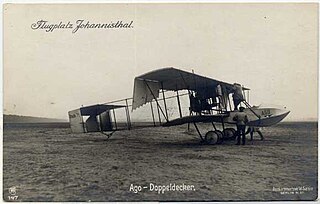
Blackburn Aircraft Limited was a British aircraft manufacturer from 1914 to 1963 that concentrated mainly on naval and maritime aircraft.

Handley Page Limited was a British aerospace manufacturer. Founded by Frederick Handley Page in 1909, it was the United Kingdom's first publicly traded aircraft manufacturing company. It went into voluntary liquidation and ceased to exist in 1970. The company, based at Radlett Aerodrome in Hertfordshire, was noted for its pioneering role in aviation history and for producing heavy bombers and large airliners.
Albatros Flugzeugwerke GmbH was a German aircraft manufacturer best known for supplying the German airforces during World War I.

Hugo Junkers was a German aircraft engineer and aircraft designer who pioneered the design of all-metal airplanes and flying wings. His company, Junkers Flugzeug- und Motorenwerke AG, was one of the mainstays of the German aircraft industry in the years between World War I and World War II. His multi-engined, all-metal passenger- and freight planes helped establish airlines in Germany and around the world.

The Etrich Taube, also known by the names of the various later manufacturers who built versions of the type, such as the Rumpler Taube, was a pre-World War I monoplane aircraft. It was the first military aeroplane to be mass-produced in Germany.
Franz Josef Popp was one of three men responsible for the founding of BMW AG and the First General Director of BMW AG from 1922 to 1942.

The Deutsche Luftstreitkräfte —known before October 1916 as Fliegertruppen —was the air arm of the Imperial German Army. In English-language sources it is usually referred to as the Imperial German Air Service, although that is not a literal translation of either name. German naval aviators of the Marine-Fliegerabteilung were an integral part of the Imperial German Navy. Both military branches operated aeroplanes, observation balloons and airships.

Gustav Otto was a German aircraft and aircraft engine designer and manufacturer.

Ignaz "Igo" Etrich was an Austrian flight pioneer, pilot and fixed-wing aircraft developer.

AGO Flugzeugwerke was a German aircraft manufacturing company from 1911 until 1945. The initials AGO had a variety of meanings during the company's lifetime, but in its final version stood for Apparatebau GmbH Oschersleben. At its peak, the company employed around 4,500 people.

Aéroplanes Hanriot et Cie. or simply 'Hanriot' was a French aircraft manufacturer with roots going back to the beginning of aviation. Founded by René Hanriot in 1910 as The Monoplans Hanriot Company Ltd. the company survived in different forms until 1916 when it established itself with the Hanriot-Dupont (HD.) fighters and observation aircraft. The company lasted through several takeovers and structural changes until in 1936 it merged with Farman to become the Société Nationale de Constructions Aéronautiques du Centre (SNCAC). 'Central Air Works' consortium.

Karl Friedrich Rapp was a German founder and owner of the Rapp Motorenwerke GmbH in Munich. In time this company became BMW AG. He is acknowledged by BMW AG as an indirect founder of the company.
Max Friz was a German mechanical engineer specializing in engine design. He was the key contributor of engine design and innovation that led to the founding of Bayerische Motoren Werke AG (BMW) in 1917.

Rapp Motorenwerke GmbH was a German aircraft engine manufacturer based in Munich, Bavaria. Founded in 1913, the firm changed its name in 1917 to Bayerische Motoren Werke GmbH (BMW). The company later became known as Süddeutsche Bremsen-AG after its engine-production assets and the BMW name were transferred in 1922 to Bayerische Flugzeugwerke, which was then renamed to Bayerische Motoren Werke AG and subsequently evolved into the automotive manufacturer known today as BMW.

Gustav Otto Flugmaschinenfabrik was a pioneering German aircraft producer during the early part of the 20th century. Founded in 1910 by Gustav Otto in Bavaria, the firm was reorganized on 7 March 1916 into Bayerische Flugzeugwerke (BFW). In 1917, a Bavarian aircraft engine maker called Rapp Motorenwerke changed its name to Bayerische Motoren Werke GmbH (BMW). That company transferred its engine-production assets and the BMW name in 1922 to Bayerische Flugzeugwerke, which was then renamed to Bayerische Motoren Werke AG and subsequently evolved into the automotive and motorcycle manufacturer that is now known as BMW.
Halberstädter Flugzeugwerke or Halberstadt was a German aircraft manufacturer. It was formed on 9 April 1912 under the name Deutsche Bristol Werke Flugzeug-Gesellschaft mbH in Halberstadt, Province of Saxony.
Rumpler-Luftfahrzeugbau GmbH, Rumpler-Werke, usually known simply as Rumpler was a German aircraft and automobile manufacturer founded in Berlin by Austrian engineer Edmund Rumpler in 1909 as Rumpler Luftfahrzeugbau. The firm originally manufactured copies of the Etrich Taube monoplane under the Rumpler Taube trademark, but turned to building reconnaissance biplanes of its own design through the course of the First World War, in addition to a smaller number of fighters and bombers.

The Rapp Rp III was a six-cylinder, SOHC valvetrain water-cooled inline aircraft engine built by Rapp Motorenwerke. Its design had been based on the previous Rapp 100 hp four-cylinder engine.
The Rapp 100 hp was a four-cylinder, SOHC valvetrain liquid-cooled inline aircraft engine built by Rapp Motorenwerke. The engine originated from Karl Rapp's earlier 90 hp four-cylinder that he had designed at the Flugwerk Deutschland GmbH for the 1912/13 Kaiserpreis aircraft engine contest.












